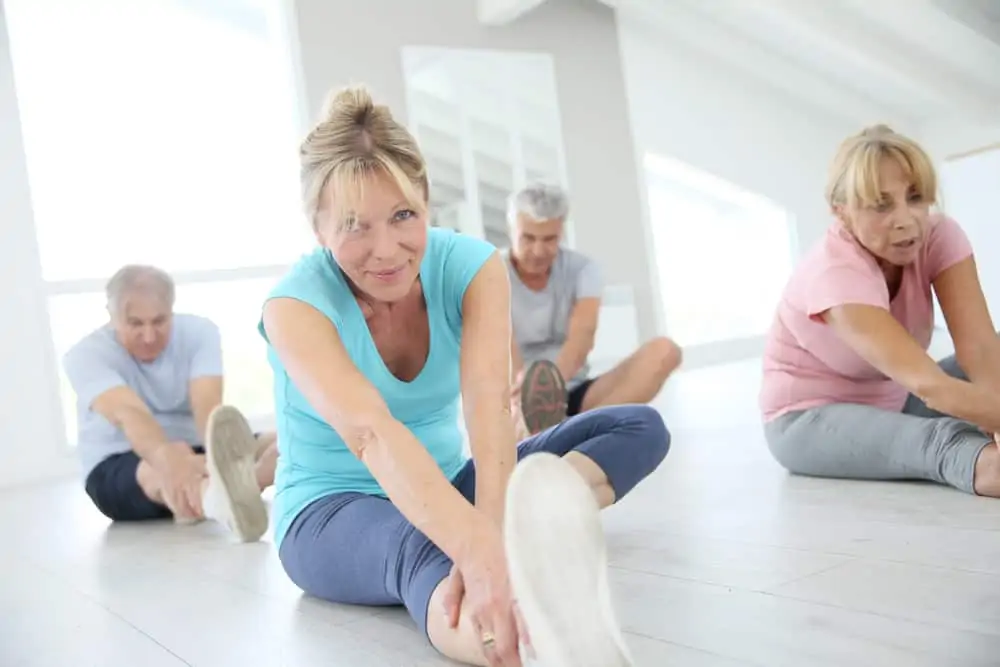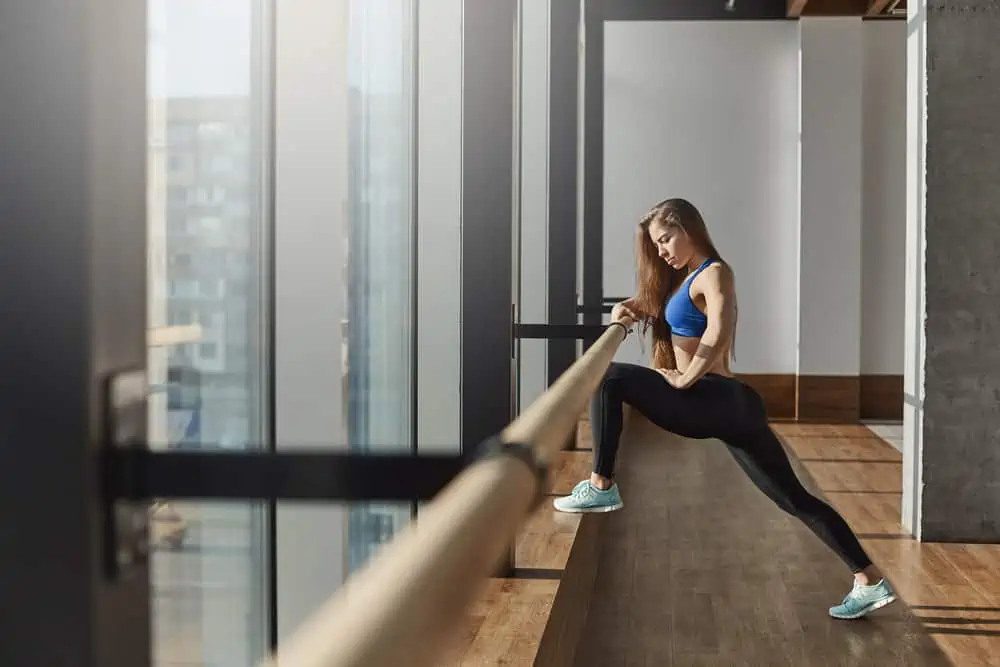This post may contain affiliate links. If you click through a link and make a purchase, I may receive a commission at no additional cost to you. As an Amazon Associate, I earn from qualifying purchases. Read the full disclosure here.
Do you feel like you never get more flexible no matter how hard you try?
Then this article is for you.
Stretching longer or “harder” isn’t the answer. In reality, that works against you.
Here are my top tips to get flexible fast. (That actually work.)
Disclaimer: This content is for educational purposes and is not medical advice. Read the full disclaimer.
Be consistent
First of all, flexibility gains don’t happen overnight.
To see improvement in your flexibility, you’ll need to establish a routine and stay consistent.
Focus on flexibility for each muscle group at least two days per week as part of your exercise routine.
The more consistent you are, the faster you’ll see improvement.
If you’re focusing on a specific area to improve, for example, calves or hamstrings, daily or even multiple times per day will help.
If you find it boring or difficult to remember to stretch, try adding a gentle yoga class (like this quick 10-minute hip stretch) into your routine.
Avoid overstretching your muscles
Flexibility is determined by the overall tone of the nervous system, so you can’t force your body into becoming more flexible.
Stretching “harder” doesn’t lead to more gains. Instead, it works against you.
Receptors in the tendons communicate with the brain and spinal cord to send the correct information back to the muscle. These receptors are also there to protect you and resist rapid changes in muscle length.
For example, if you move too quickly or too far into a range of motion (ROM), the receptors interpret this as dangerous and do not allow the movement as a protective response.
Forcing a stretch is counterproductive and can even lead to an injury. Ballistic stretching (bouncing while stretching) is also not recommended.
If you always feel tight despite lots of stretching, there’s probably another piece of the puzzle that needs to be addressed.
Read How To Avoid Overstretching Your Muscles for more details and tips to keep yourself safe during stretching.
Use a stretch strap
Instead of risking an injury from overstretching, use a stretch strap to help lengthen your reach so you can comfortably target the right areas and keep your form in check.
My favorite stretch strap is the Original Stretch Out Strap because it has a series of loops along the length of the strap. There’s always a handle for you no matter what your flexibility level is at.

Give yourself time
Most don’t give their body enough time to respond to the stretch before they’re off to the next thing.
For static stretching, try holding your position for at least 20-30 seconds for 2-3 rounds while taking slow deep breaths.
This allows your body to respond to the stretch and start to let go.
If you’re finding it difficult to keep breathing slowly and deeply, that’s a clue that you need to back off slightly until you can maintain that connection to your breath.
Try dynamic stretching
There are a lot of different types of stretching exercises.
Static stretching can effectively increase flexibility and is best used at the end of physical activity.
Dynamic stretching involves moving your body through functional, activity-specific motions. Examples of dynamic stretches are walking lunges, leg swings, torso twists, etc.
This type of stretching is best performed after 5-10 min of low-intensity aerobic activity as part of a warm-up. It can help reduce injury by preparing the body for activity-specific movements.
Try contract-relax stretching
Contract relax stretching is sometimes referred to as PNF (proprioceptive neuromuscular facilitation). However, contract relax is merely one of the many PNF techniques.
Contract-relax stretching works by intermittently engaging the muscle (gently) and then relaxing further into the range of motion.
Add mobility work
Mobility exercises are having a moment right now, but they’re not exactly a new concept.
Mobility essentially means how freely and easily you can move your body, and it’s an essential component for injury prevention, no matter what your fitness level.
Muscles aren’t just the only thing that controls flexibility. For example, if you lack range of motion, then soft tissues can only move so far.
Using tools like foam rollers or the chirp wheel can help increase your mobility.
Save Over 50% On The Ultimate Back Pain Bundle by Chirp + Free Shipping Over $99
Add mobility work to ensure you have full range of motion.
Stretch after foam rolling
Using a foam roller may be effective for enhancing joint ROM for both pre and post-exercise.
Foam rollers may also decrease tissue tension and muscle soreness, increase local temperature and reduce pain.
Studies show that the benefits of foam rolling are best when combined with a stretching and mobility program.
After foam rolling (or using a massage gun), take some time to work through that range of motion for maximum benefit.
Strengthen your muscles
Many people think that strengthening will make your muscles tighter. In reality, strength training can improve your flexibility.
Muscle weakness can also be perceived as tightness. However, just because something “feels tight,” it doesn’t mean stretching is the only answer.
A classic example is feeling like you always have tight hamstrings.
Focusing on strength exercises, especially eccentric exercises (strengthening while the muscle is lengthening), can bring significant improvements to your flexibility.
The stronger you get, the more your body will trust you with range of motion.
Don’t ignore your breath
Deep breathing is a natural hack into the nervous system and is often overlooked, though it’s a valuable tool to improve flexibility.
Deep breathing has a connection to the vagus nerve, the longest cranial nerve in the body, running through the throat, chest, and abdomen.
Deep breathing mobilizes the vagus nerve to help elicit a relaxation response to decrease heart rate, blood pressure and reduce the concentration of stress hormones circulating the body.
Slow, controlled breaths can signal to the nervous system that everything is fine and help your body relax and move better.
Holding your breath or breathing out of sync with your activities can limit your mobility, among other issues.
If you’re finding it difficult to keep breathing slowly and deeply, that’s a clue that you need to back off slightly until you can maintain that connection to your breath.
Related read: Easy Breathing Exercises For Low Back Pain
Take movement breaks during the day
If you have a great workout or yoga class but then stay still for the other 23 hours of the day, you won’t see flexibility gains.
Take regular breaks to move and stretch during the day to maintain that range of motion functionally.
How long until I get more flexible?
Research shows that everyone has a different baseline of flexibility controlled by various factors, including anatomy and proportions and the overall tone of the nervous system.
While not everyone will do a split (despite the emotionally charged verbiage on a spammy Facebook ad peddling a flexibility program), research shows that the average person can expect to improve their flexibility by at least 25%.
With a proper, consistent program, you should expect to see flexibility gains within a few weeks to a few months.
Remember, to maintain those gains, you need to keep up with your program.
If you stop, your flexibility will decrease.
Wrapping up
Good flexibility allows for improved mobility. Improved mobility enables you to move into positions with greater ease and less dysfunctional strain on tissues, helping to prevent wear and tear on your body.
Learning how to stretch the right way can help you maintain range of motion and flexibility.
References
Hodges, Paul & Gurfinkel, Victor & Brumagne, Simon & Smith, T & Cordo, P. (2002). Coexistence of stability and mobility in postural control: Evidence from postural compensation for respiration. Experimental brain research. Experimentelle Hirnforschung. Expérimentation cérébrale. 144. 293-302. 10.1007/s00221-002-1040-x.
Mahieu, Nele & Danneels, Lieven & McNair, Peter. (2004). Stretching and injury prevention – An obscure relationship. Sports medicine (Auckland, N.Z.). 34. 443-9.
Page P. Current concepts in muscle stretching for exercise and rehabilitation. Int J Sports Phys Ther. 2012;7(1):109-119.







